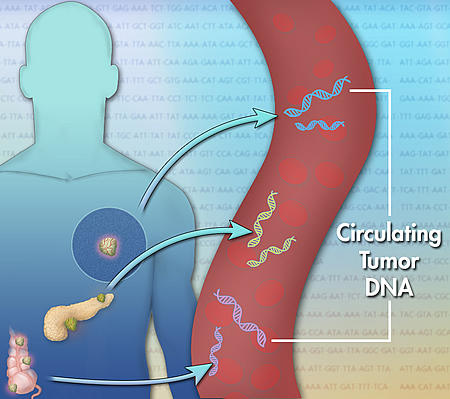
Blood Tests for Circulating Tumor DNA Raise Hopes and Questions The emergence of blood tests for circulating tumor DNA (ctDNA) has ignited a surge of excitement and speculation within the medical community. These tests analyze fragments of tumor DNA that are shed into the bloodstream as a tumor grows and metastasizes. By detecting ctDNA, doctors may gain insights into various aspects of cancer, including diagnosis, prognosis, and treatment monitoring. Benefits of ctDNA Blood Tests: * Early detection: ctDNA tests can detect cancer at an early stage, even before tumors are visible on imaging tests. This has the potential to improve patient outcomes by enabling prompt treatment. * Personalized treatment: ctDNA profiles can provide information about the genetic makeup of a tumor, guiding personalized treatment plans that target specific mutations. * Real-time monitoring: Repeated ctDNA tests can monitor the effectiveness of treatment over time and detect recurrence of cancer early. * Less invasive than biopsies: ctDNA blood tests are less invasive than biopsies, which can be particularly beneficial for patients who are too frail or who have tumors in difficult-to-reach locations. Unanswered Questions and Challenges: Despite the promise of ctDNA blood tests, several unanswered questions and challenges remain: * Sensitivity and specificity: Determining the optimal threshold for detecting ctDNA and distinguishing it from background DNA remains a challenge. It is crucial to minimize false positives and false negatives to ensure accurate diagnosis and prognosis. * Clinical utility: Further research is needed to establish the clinical utility of ctDNA tests in specific cancer types and disease stages. Longitudinal studies are necessary to determine their impact on patient outcomes. * Standardization: There is a need for standardized protocols for ctDNA testing to ensure consistent results across different laboratories and over time. This is essential for comparing results and making informed clinical decisions. * Cost and accessibility: While ctDNA tests have the potential to revolutionize cancer care, their cost and accessibility must be addressed to ensure equitable access for all patients. Conclusion: Blood tests for circulating tumor DNA hold immense promise for improving cancer diagnosis, treatment, and monitoring. However, ongoing research is necessary to address unanswered questions, refine testing methods, and establish their clinical utility. As these challenges are overcome, ctDNA blood tests are poised to play a transformative role in the fight against cancer.
The hopes that many cancer patients who undergo surgery will be cured after the surgeon removes the tumor. The question that lingers is whether they all came out–whether the surgery took place in time before the cancer cells spread from the primary tumor to cause invisible metastases, or whether a microscopic malignancy was left behind near the original cancer place.
The hopes that many cancer patients who undergo surgery will be cured after the surgeon removes the tumor. The question that lingers is whether they all came out–whether the surgery took place in time before the cancer cells spread from the primary tumor to cause invisible metastases, or whether a microscopic malignancy was left behind near the original cancer place.
To answer this question, doctors are increasingly turning to blood tests that detect circulating tumor DNA, known as ctDNA. The idea is that finding tumor DNA in the blood likely means that cancer cells are still growing somewhere in the body, even at low levels. These tests are used for several types of cancer–and doctors largely agree that if the test is positive, the cancer is likely to return. The problem is that scientists aren’t sure what to do next.
“We all recognize that if a patient has detectable circulating tumor DNA, the question is not if the cancer will come back, but when,” says Van Morris, a gastrointestinal medical oncologist at MD Anderson Cancer Center. “The field recognizes the power of this tool, but I think many questions remain about how we can best use it in the daily treatment of patients.”
Blood Tests for Circulating Tumor DNA Raise Hopes and Questions Blood tests that detect circulating tumor DNA (ctDNA) are offering new insights into cancer diagnosis, prognosis, and treatment monitoring. These tests analyze cell-free DNA fragments released into the bloodstream by tumor cells, providing a non-invasive method for detecting and tracking cancer. Improved Diagnosis and Monitoring ctDNA tests can be used to diagnose cancer at an earlier stage than traditional biopsy methods. They can also be used to monitor the effectiveness of treatment and detect recurrence, allowing for timely intervention. For example, ctDNA levels can indicate treatment resistance or the development of new tumors. Personalized Treatment Plans ctDNA analysis can provide valuable information for tailoring treatment plans. By detecting specific genetic alterations in tumor cells, doctors can select therapies that are most likely to be effective. This precision medicine approach can improve outcomes and reduce side effects. Screening and Prevention Researchers are exploring the potential of ctDNA tests for screening high-risk individuals and preventing cancer development. By detecting ctDNA in the blood, it may be possible to identify precancerous lesions or early-stage cancers that would not have been found through routine screening methods. Challenges and Concerns While ctDNA tests offer promise, they also raise some challenges and concerns: * Sensitivity: ctDNA levels can vary widely, making it difficult to detect small or early-stage tumors. * Specificity: ctDNA tests can sometimes detect ctDNA from non-cancerous sources, leading to false positives. * Data interpretation: Interpreting ctDNA data requires specialized knowledge and expertise. * Cost: ctDNA testing can be expensive, limiting its widespread use. Future Directions Ongoing research aims to address these challenges and further improve the utility of ctDNA tests. Advances in technology and data analysis methods hold the potential to increase sensitivity, specificity, and cost-effectiveness. Conclusion Blood tests for ctDNA have emerged as a promising tool for cancer diagnosis, prognosis, and treatment monitoring. While some challenges remain, these tests offer significant hope for improving cancer care. Further research and refinement will be crucial to unlocking the full potential of ctDNA testing.